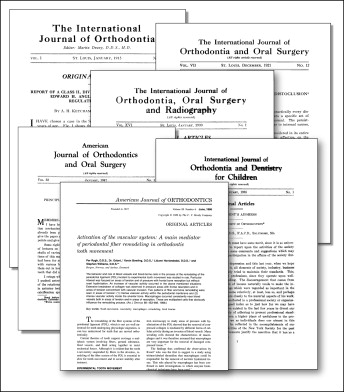Less than a year from now, the editors of your Journal will ask you to join in celebrating 100 years of the American Journal of Orthodontics & Dentofacial Orthopedics ( AJO-DO ). The first issue was published in January 1915. Few professional publications have such an exceptional record of continuous monthly publication. Over this period of time, the Journal has done well, surviving 2 world wars, a devastating depression, name changes, and staff and ownership changes, not to mention technological changes that have radically altered the publication of research findings designed to improve patient care. This is the Journal ‘s year to celebrate, because few specialty publications—medical or dental—can claim such a remarkable publication record. The first issue of the Journal of the American Dental Association was published 3 months after the AJO-DO ‘s first issue.
Take a few moments to look at the very first issue of the AJO-DO . Log in to the Journal ‘s Web site, ajodo.org , and select the “Back Issue” menu near the top of the screen, 1915-1918 issues, and then open up Volume 1, Issue 1, of the International Journal of Orthodontia , published in January 1915. The physicians who started the C. V. Mosby Company initially had their eyes on Edward H. Angle to be the first editor, but he turned down the job because another journal he started in 1901 had already failed due to a lack of support. Martin Dewey was enticed to take on the job as editor. In those early days, editors had to have their own sources of material or write the articles themselves. Orthodontia was not yet taught as a specialty in dental schools. In 1915, there were no university orthodontic programs—only preceptorships and a few private proprietary courses. There was no way of officially recognizing the qualifications of either the preceptor or the private school. It would be 15 years before the American Board of Orthodontics would be formed to certify graduates.
The International Journal of Orthodontia had its share of problems during those early days because the specialty remained small, and publishable articles continued to be scarce. In 1917, this lack of material reached a low point, and Martin Dewey came to the rescue by writing 3 clinical articles himself. Soon after, he arranged a mutually advantageous union between the Journal and the American Society of Orthodontists while also serving as chairman of the Department of Orthodontia at the University of Iowa. Bernhard W. Weinberger’s extensive writings describing the history of orthodontics were published in what was then known as the International Journal of Orthodontia, Oral Surgery, and Radiography .
Changes in the Journal ( Fig ) often reflect changes in society. In the first decade of professional publications initiated by Mosby, the economy was robust, marked by the rise of industrial leaders, such as Henry Ford. We could add Edward H. Angle to this group, with his creation of orthodontic appliances and his scholarly optimism leading to early specialty courses. Yes, he even purchased a new Model T Ford, which he regularly drove to the beach at Santa Monica. But everything changed with the Great Depression of the 1930s and the dramatic loss of jobs, which led to fewer opportunities, fewer patients, and reduced treatment fees. Scientific publications struggled for financial stability, and many were discontinued.





